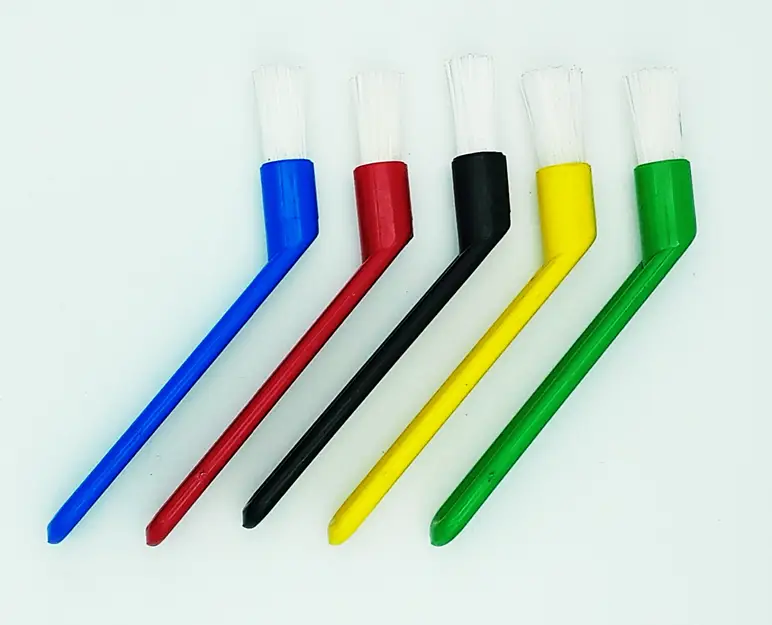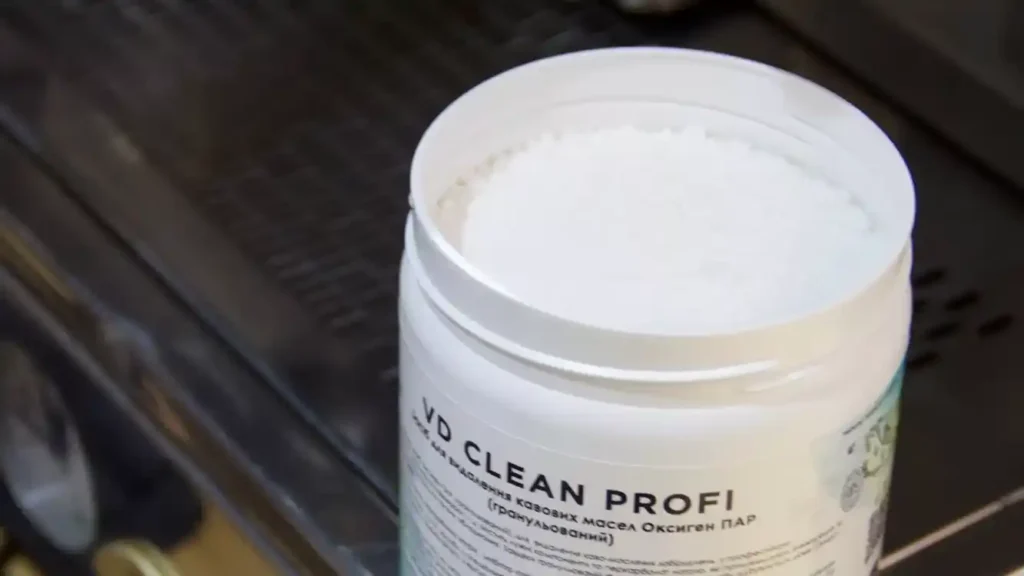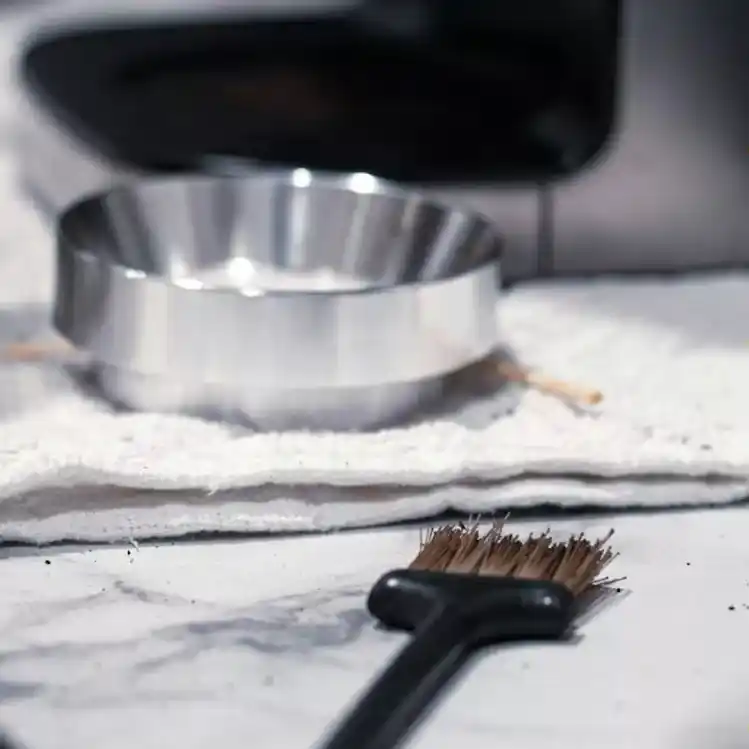Why regular cleaning of coffee equipment is important
Coffee oil residues, scale, bacteria and fungi gradually accumulate inside the coffee machine or coffee maker.
Without regular cleaning of the equipment, the taste of coffee becomes sour and bitter, as the grinding residues are oxidized.
Scale that forms on heating elements reduces efficiency and shortens the service life of the equipment.
In addition, in a humid environment, harmful microorganisms multiply, which negatively affect human health.
General principles of coffee equipment maintenance
Before cleaning, be sure to unplug the appliance and let it cool down. In addition, it is important to read the user manual, as different models may have their own unique features.
The frequency of care depends on the intensity of use.
Remove coffee residue and rinse moving parts daily.
It is important to clean the brewing unit, drip tray, and milk systems on a weekly basis.
And finally, deep cleaning, decalcification, and maintenance of the grinder are required every month.
Necessary tools and products for cleaning equipment
To keep your coffee machine running for a long time and delivering delicious coffee every day, you should have a few proven cleaning products on hand. First, there are specialized products that are designed specifically for coffee equipment. These include decalcification tablets or powders that remove scale, special products for removing oils that accumulate over time, milk circuit cleaners (relevant for machines with cappuccino machines), and espresso group cleaners.
In some cases, especially if you don’t have professional products on hand, you can use household alternatives. For example, baking vinegar or citric acid are classic options for descaling, but they should be used very carefully to avoid damaging the internal elements of the machine. You may also need baking soda, a soft sponge, and brushes for narrow channels.
And don’t forget about the little things that make the process much easier: microfiber cloths, brushes for cleaning small parts, a backup container for flushing the system, and a dry cloth.
With this basic set, you’ll always be prepared for routine or emergency cleaning of your coffee machine.

How to clean an automatic coffee machine
Regular cleaning of your automatic coffee machine is not only about cleanliness, but also about stable operation, longevity, and the quality of each cup of coffee. Just a few simple but important steps will help keep your machine in top condition.
You should clean the brewing unit at least once a week. Take it out of the machine (most models do this without tools), rinse it gently under running warm water without detergents. It is important to allow the unit to dry completely naturally before reinserting it. Moisture inside can cause mold or malfunctions.
Depending on the water hardness in your area, decalcification should be performed every 1-3 months. Turn on the automatic decalcification program (almost all modern models have it) by first adding a substance to the water tank according to the manufacturer’s instructions. The process takes about 20-30 minutes, but the result is worth it: the internal circuits are cleaned of limescale, which can slow down or block the water supply.
If you have a coffee machine with a cappuccino machine or milk container, always clean the milk system. Milk residues deteriorate very quickly and the system becomes dirty. After each use, it is advisable to run the milk circuit cleaning program or manually run water and detergent through the tubes. Afterwards, make sure to rinse everything with clean water so that no cleaning solution remains.
The exterior of the machine also needs to be maintained. Use a soft microfiber cloth to wipe the body, display and drip tray. Do not allow excessive moisture to get inside, especially into the electronic components. Regular wiping not only maintains the attractive appearance of the equipment, but also prevents the accumulation of dirt and drips.
Caring for drip coffee makers
Drip coffee makers are easy to use and ideal for daily coffee brewing, but even such low-maintenance equipment requires regular maintenance. It doesn’t take much time, but it helps to avoid unpleasant taste, mold, and breakage.
Rinse the water tank at least once a week to prevent the build-up of mucus and bacteria. Once a month, you should decalcify it. This will help clean the internal elements from limescale, especially if you have hard water. To do this, use special products or household analogs (for example, a vinegar solution).
After each brew, discard the disposable filter with the grounds. If you are using a reusable filter, be sure to rinse it thoroughly after each use to avoid any oil residue. It is also important to allow it to dry completely before using it again, as excessive moisture can lead to mold and odor.
Although we can’t see it, the heating element is responsible for the brewing temperature and thus the taste of the coffee. One of the most effective ways to clean it is to run a 1:1 solution of vinegar and water through the coffee maker. After that, be sure to repeat the cycle 2-3 times with clean water to completely get rid of the odor and acid residue.
After each use, clean the decanter with warm water and mild detergent. Avoid using hard sponges or metal brushes, which can leave scratches that collect plaque over time and alter the taste of the coffee. If the pitcher becomes stained, try a mild solution of baking soda or lemon juice for easy cleaning.

How to clean your espresso machine
An espresso machine is a device for creating the perfect espresso. To ensure stable operation and richness of the drink, you need to regularly maintain the main elements of the system. This is very important for semi-automatic and manual models that do not have built-in cleaning programs.
The portafilter and sieve are the parts through which the coffee passes. They are the parts that are most in contact with coffee oils and residues. After each brew, rinse the portafilter and strainer thoroughly under hot water to prevent grind residue from accumulating. Once a week, be sure to soak them in a special solution to remove oils. This will not only extend the service life of the parts, but also improve the taste of the espresso.
The group head is the heart of the espresso machine. After each use, you should brush it to remove grind residue. And once every few days, or at least once a week, carry out a backwash procedure using the appropriate tablets. The procedure cleans the valves, internal channels, and removes coffee oil buildup. This is a simple but crucial step in maintaining the machine.
After each cappuccino or latte, wipe the steam pipe immediately with a damp cloth to prevent the milk from drying out. If you leave it until later, it will be more difficult to remove any residue. Once a week, we recommend a deep cleaning: immerse the tube in a detergent solution and apply steam to clean the inside as well. This will help to avoid unpleasant odors, blockages and spoilage of the taste of drinks.
Cleaning capsule coffee makers
Due to the closed system, most of the internal elements of capsule coffee makers are inaccessible to the user, so it is important to perform basic cleaning procedures regularly.
The piercing needle that punctures the capsule during brewing can become clogged with coffee residue or capsule particles over time. It should be carefully cleaned with a special brush or even a toothpick.
Since water is constantly circulating inside the system, scale formation is inevitable. About once a month, you should run a cleaning program using a special decalcification solution according to the manufacturer’s instructions.
Don’t forget about the used capsule container and drip tray. These parts come into contact with moisture and coffee residue, so they should be cleaned at least once a week to prevent odors and mold.
It is advisable to wash the water tank every 2-3 days and add fresh, clean water before cooking. Do not leave it filled for a long time, especially during the warm season.
Caring for alternative coffee brewing accessories
Alternative coffee equipment and its care, in brief:
French press:
- Disassemble completely, rinse every part.
- Remove sediment from the walls and grid with a brush.
Purover, cupcake:
- Wash with warm water and mild detergent.
- Do not wash the glass parts in the dishwasher!
- Disassemble, rinse without detergents.
- Do not use in the dishwasher.
Turk:
- Rinse immediately after use.
- Avoid abrasives.
Aeropress, siphon:
- Wash immediately and brush the seals.
- Dry thoroughly before storage.
Cleaning and adjusting the grinders
The grinder should be cleaned with a brush or vacuum cleaner. Before doing so, be sure to turn off the power and disassemble the machine according to the instructions.
Knife models can be cleaned periodically with a dry method: grind a small amount of rice or bread crumbs. But do not overuse this method to avoid damaging the knives.
Manual grinders should be completely disassembled and all parts should be wiped with a dry cloth. If the design allows, you can lubricate the moving parts.
Combatting limescale and coffee oils
Scale is the main enemy of heating elements, which leads to a decrease in water temperature and damage to the boiler or thermoblock.
To combat it, special decalcification liquids are needed.
As a last resort, you can take food vinegar (1:1 with water).
Coffee oils oxidize and give off an unpleasant flavor, so it’s important to remove them in time. They can be removed with tablets or special products.
Common mistakes when cleaning coffee equipment
Avoid using abrasive materials, as this will cause scratches and damage.
Washing electrical parts with water is prohibited due to the risk of short circuits.
Using household acids without observing the recommended proportions can damage the seals.
Decalcification should not be ignored. Without it, the equipment will last much shorter.
Only with a clean heart and clean dishes can you make the perfect coffee.








